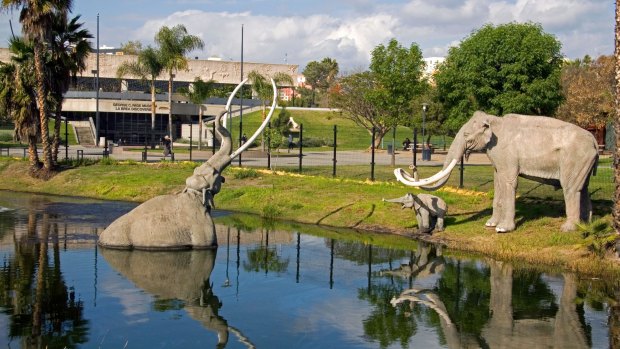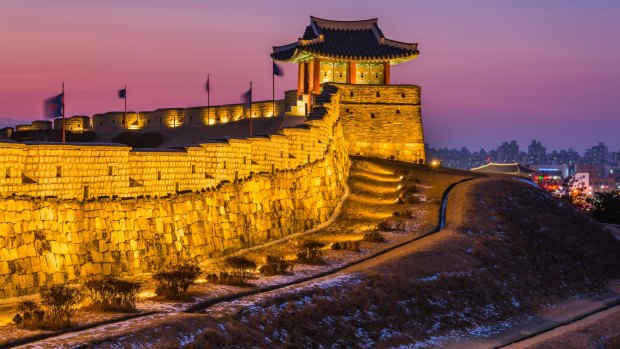This was published 5 years ago
From Roman Paris to Sydney rock art: Ten amazing heritage sites in modern cities

La Brea Tar Pits, Los Angeles: Nobody quite knows the age of the La Brea Tar Pits, surrounded by Hancock Park in LA. Uncovered by excavation in the early 20th century, these pits trapped animals, and over the years thousands of fossils have emerged from the pits.Credit: Alamy
Modern cities can often be all about the gleaming skylines, with the past largely buried – but snoop around and you can find surprising heritage sites. Meanwhile, in others, the history goes back way further than might be imagined…
Arenes de Lutece, Paris
We've got the building of a tramway depot in the 19th century to thank for the discovery of Paris' Roman arena, built a trifling 18 centuries earlier. It has since been excavated and preserved as well as possible. Archaeologists think the amphitheatre – which had an unusually long 41.2-metre stage – was used for both theatrical productions and gladiatorial combat. It now sticks out like a sore thumb in the Latin Quarter. See parisinfo.com

Seoul City Wall, Seoul: Most of the Seoul City Wall, made of stone and wood in the 1400s and stretching 18.6km around the city, has been torn down but a few sections remain, some restored and others unaltered. The south gate, which has been restored, is the single most impressive sight. Credit: Alamy
The London Wall, London
Paris isn't the only great European city with Roman remains – some can be found in London too. There are fragments of the original Roman Wall throughout the City of London – with a significant chunk outside the Tower Hill tube station. But the most impressive site is the amphitheatre that was uncovered beneath the Guildhall Art Gallery in the 1980s. No one knows exactly when it was built, but it's thought to date to the first century AD. See cityoflondon.gov.uk
Aboriginal rock art, Sydney
Heritage sites in Sydney generally relate to the early colonial era, but there are plenty of traces from before the Europeans arrived. There are rock art sites in the Sydney Harbour National Park – they can be seen on the Spit Bridge to Manly Walk – but absolutely loads in the Ku-Ring-Gai Chase National Park. Sydney Out Back runs tours to check out some of the 1500 pieces of rock art uncovered there. See sydneyoutback.com.au
La Brea Tar Pits, Los Angeles
Nobody quite knows how old the La Brea Tar Pits, surrounded by Hancock Park in LA, are. Uncovered by excavation in the early 20th century, these pits acted as a trap for animals that sauntered over them, and over the years thousands of fossils have been found in there. Given that these include bones belonging to mammoths and sabre-toothed cats – now displayed in the neighbouring Page Museum – it's fair to say they've been down there for a while. See tarpits.org
Groot Constantia, Cape Town
Africa isn't exactly known for its wine regions – and the South African wine industry tends to be thought of as a new world, modern thing. So it's something of a surprise to learn that the country's oldest winery dates back to 1695. Groot Constantia, in the leafy suburbs of Cape Town, offers tours of the old Dutch-style property as well as wine tastings and lavish lunches. See grootconstantia.co.za
Al Fahidi Fort, Dubai
Dubai's growth has been remarkable, given that there was virtually nothing there in the 1960s. But it didn't quite spring up from the desert out of nothing. The Al Fahidi Fort – which now hosts the Dubai Museum – is just set back from the Dubai Creek, where most of the vaguely historic buildings can be found. Made from coral rock, it was built in… 1787. See dubaiculture.gov.ae
Cooks' Cottage, Melbourne
Given that Australia wasn't even settled by Europeans until 1788, it may seem a little odd that a cottage in the Fitzroy Gardens dates back to 1755. That's because it was originally built in England – then removed and rebuilt brick by brick. The somewhat eccentric quest of industrialist Sir Russell Grimwade saw the home of Lt James Cook's parents moved from the village of Great Ayton in North Yorkshire. See whatson.melbourne.vic.gov.au
Seoul City Wall, Seoul
The South Korean capital generally presents as shiny and modern, but snaking through it is a reminder of the 1400s. Most of the Seoul City Wall, originally made of stone and wood and stretching 18.6km around the city, has been torn down to make way for roads, train lines and buildings. But a few sections remain, some restored and others not altered in 600 years. The south gate, which has been restored, is the single most impressive sight. See visitseoul.net
Huaca Huallamarca, Lima
In among the bank buildings of Lima's San Isidro district – Peru's de facto financial centre – stands an adobe pyramid. It has had plenty of remedial work over the years, and goodies found inside – such as dolls, ceramics and even a mummified body – have been moved to a neighbouring museum. But it is thought that the pyramid originally belonged to the pre-Columbian Lima Culture, and could date back as far as AD200. See msi.gob.pe
Fort Canning, Singapore
Tales of Singapore's history generally start with the arrival of Stamford Raffles in 1819, but there was once a 14th century kingdom based around what is now Fort Canning. And archaeological excavations have uncovered numerous artefacts related to Singapura. There's still a small archaeological site open to visitors – you'll find it next to the spice garden. See nparks.gov.sg
Sign up for the Traveller newsletter
The latest travel news, tips and inspiration delivered to your inbox. Sign up now.